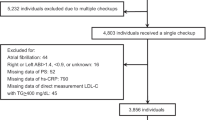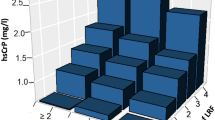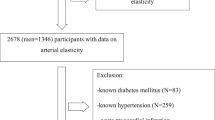Abstract
Plasma concentration of high sensitive C-reactive protein (hsCRP) is used as a marker for inflammatory states and is directly correlated with the risk for coronary heart disease. Evidence concerning the role of inflammation in atheroma formation has been derived from several models of atherosclerosis. Inflammation should exert its adverse vascular effects by structural changes in the artery wall and consequently alterations in arterial elasticity, which could be detected already in asymptomatic early vascular disease. We hypothesized that CRP is related to large artery elasticity, but not to small artery elasticity in early vascular disease. Therefore, we examined the association between arterial stiffness of large and small arteries and inflammation in an asymptomatic population referred for primary prevention cardiovascular screening. Studies were performed in 391 subjects (age 21–82 years; 254 men, 137 women) who underwent screening at the Cardiovascular Disease Prevention Center. Large artery (C1) and small artery (C2) elasticity indices were obtained by the CVProfiler 2000 (HDI, Eagan, MN, USA). After overnight fasting, venous samples were taken for measurement of hsCRP, lipids, glucose. There was a significant inverse correlation between hsCRP (0.29±0.40 mg/dl) and C1 (16.7±5.8 ml/mmHg), r=−0.133, P=0.01; there was no significant correlation between hsCRP and C2 (6.6±3.2 ml/mmHg). C2, but not hsCRP, was inversely correlated with age, abnormal lipids and glucose, whereas C1, but not hsCRP, was inversely correlated with age and systolic blood pressure (SBP). In multiple regression analysis, the relationship between hsCRP and C1 was not affected by age, body mass index, SBP, serum glucose or lipids. In conclusion, these findings support the hypothesis that hsCRP, a marker for acute and low-grade inflammation, is associated with large artery but not with small artery elasticity in asymptomatic individuals undergoing primary prevention cardiovascular screening.
This is a preview of subscription content, access via your institution
Access options
Subscribe to this journal
Receive 12 digital issues and online access to articles
$119.00 per year
only $9.92 per issue
Buy this article
- Purchase on Springer Link
- Instant access to full article PDF
Prices may be subject to local taxes which are calculated during checkout

Similar content being viewed by others
References
Hackman A et al. Levels of soluble cell adhesion molecules in patients with dyslipidemia. Circulation 1996; 93: 1334–1338.
Hwang SJ et al. Circulating adhesion molecules VCAM-1, ICAM-1, and E-selectin in carotid atherosclerosis and incident coronary heart disease cases: the Atherosclerosis Risk In Communities (ARIC) study. Circulation 1997; 96: 4219–4225.
Ridker PM et al. Plasma concentration of soluble intercellular adhesion molecule 1 and risks of future myocardial infarction in apparently healthy men. Lancet 1998; 351: 88–92.
Ross R . Pathogenesis of atherosclerosis: a perspective for the 1990s. Nature 1993; 362: 801–809.
Libby P, Ridker PM, Maseri A . Inflammation and atherosclerosis. Circulation 2002; 105: 1135–1143.
Ridker PM . C-reactive protein and risks of future myocardial infarction and thrombotic stroke. Eur Heart J 1998; 19: 1–3.
Ridker PM et al. Inflammation, aspirin and the risk of cardiovascular disease in apparently healthy men. N Engl J Med 1997; 336: 973–979.
Erren M et al. Systemic inflammatory parameters in patients with atherosclerosis of the coronary and peripheral arteries. Arterioscler Thromb Vasc Biol 1999; 19: 2355–2363.
Ridker PM et al. Plasma concentration of C-reactive protein and risk of developing peripheral vascular disease. Circulation 1998; 97: 425–428.
Van Der Meer IM et al. C-reactive protein predicts progression of atherosclerosis measured at various sites in the arterial tree: the Rotterdam Study. Stroke 2002; 33: 2750–2755.
Folsom AR et al. Investigators of the NHBLI Family Heart Study. Association of C-reactive protein with markers of prevalent atherosclerotic disease. Am J Cardiol 2001; 88: 112–117.
Juonala M et al. Interrelations between brachial endothelial function and carotid intima-media thickness in young adults: the cardiovascular risk in young Finns study. Circulation 2004; 110: 2918–2923.
Finkelstein SM, Cohn JN . First- and third-order models for determining arterial compliance. J Hypertens Suppl 1992; 10: S11–14.
Glasser SP et al. Vascular compliance and cardiovascular disease: a risk factor or a marker? Am J Hypertens 1997; 10: 1175–1189.
Laurent S et al. Aortic stiffness is an independent predictor of all-cause and cardiovascular mortality in hypertensive patients. Hypertension 2001; 37: 1236–1241.
Cohn JN . Arterial compliance to stratify cardiovascular risk: more precision in therapeutic decision making. Am J Hypertens 2001; 14: 258S–263S.
Cohn JN et al. Noninvasive pulse wave analysis for the early detection of vascular disease. Hypertension 1995; 26: 503–508.
Pasceri V, Willerson JT, Yeh ET . Direct proinflammatory effect of C-reactive protein on human endothelial cells. Circulation 2000; 102: 2165–2168.
Zwaka TP, Hombach V, Torzewski J . C-reactive protein-mediated low density lipoprotein uptake by macrophages: implications for atherosclerosis. Circulation 2001; 103: 1194–1197.
McVeigh GE et al. Nitric oxide modulation of blood vessel tone identified by arterial waveform analysis. Clin Sci (London) 2001; 100: 387–393.
Yasojima K, Schwab C, McGeer EG, McGeer PL . Generation of C-reactive protein and complement components in atherosclerotic plaques. Am J Pathol 2001; 158: 1039–1051.
Yudkin JS, Stehouwer CD, Emeis JJ, Coppack SW . C-reactive protein in healthy subjects: associations with obesity, insulin resistance, and endothelial dysfunction: a potential role for cytokines originating from adipose tissue? Arterioscler Thromb Vasc Biol 1999; 19: 972–978.
Hak AE et al. Associations of C-reactive protein with measures of obesity, insulin resistance, and subclinical atherosclerosis in healthy, middle-aged women. Arterioscler Thromb Vasc Biol 1999; 19: 1986–1991.
Frohlich M et al. Association between C-reactive protein and features of the metabolic syndrome: a population-based study. Diabet Care 2000; 12: 1835–1839.
Moreno PR, Fuster V . The year in atherothrombosis. J Am Coll Cardio 2004; 44: 2099–2110.
Libby P . Vascular biology of atherosclerosis: overview and state of the art. Am J Cardiol 2003; 91: 3A–6A.
Stocker R, Keaney Jr JF . Role of oxidative modifications in atherosclerosis. Physiol Rev 2004; 84: 1381–1478.
Labarrere CA, Zaloga GP . C-reactive protein: from innocent bystander to pivotal mediator of atherosclerosis. Am J Med 2004; 117: 499–507.
McVeigh GE et al. Age-related abnormalities in arterial compliance identified by pressure pulse contour analysis: aging and arterial compliance. Hypertension 1999; 33: 1392–1398.
Author information
Authors and Affiliations
Corresponding author
Rights and permissions
About this article
Cite this article
Duprez, D., Somasundaram, P., Sigurdsson, G. et al. Relationship between C-reactive protein and arterial stiffness in an asymptomatic population. J Hum Hypertens 19, 515–519 (2005). https://doi.org/10.1038/sj.jhh.1001860
Received:
Revised:
Accepted:
Published:
Issue Date:
DOI: https://doi.org/10.1038/sj.jhh.1001860
Keywords
This article is cited by
-
Associations of plasma omega-3 and omega-6 pufa levels with arterial elasticity: the multi-ethnic study of atherosclerosis
European Journal of Clinical Nutrition (2022)
-
Transcriptome sequencing of Eospalax fontanierii to determine hypoxia regulation of cardiac fibrinogen
Molecular Biology Reports (2019)
-
Cardiovascular disease risk in people with spinal cord injury: is there a possible association between reduced lung function and increased risk of diabetes and hypertension?
Spinal Cord (2017)
-
Neutrophil-lymphocyte ratio is associated with arterial stiffness in patients with peritoneal dialysis
BMC Nephrology (2016)
-
Physical Activity in Overweight and Obese Adolescents: Systematic Review of the Effects on Physical Fitness Components and Cardiovascular Risk Factors
Sports Medicine (2014)



